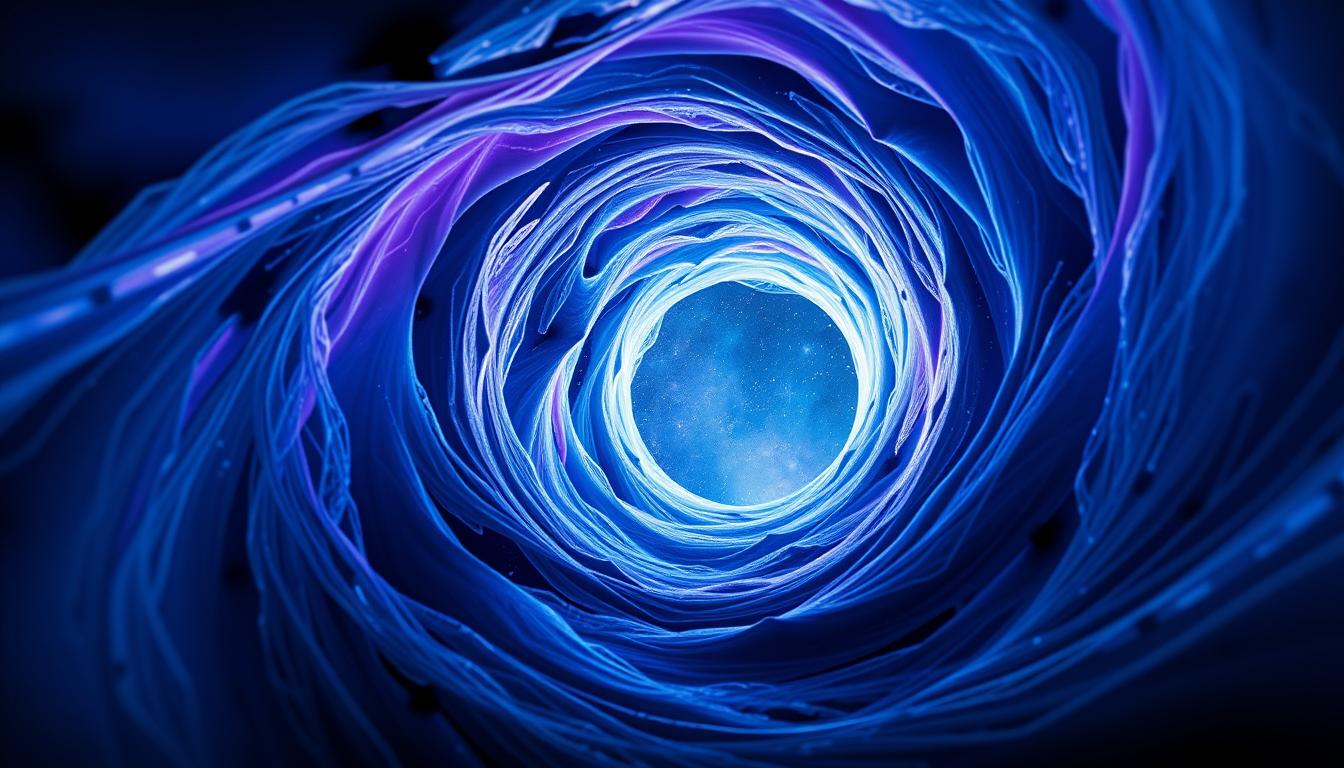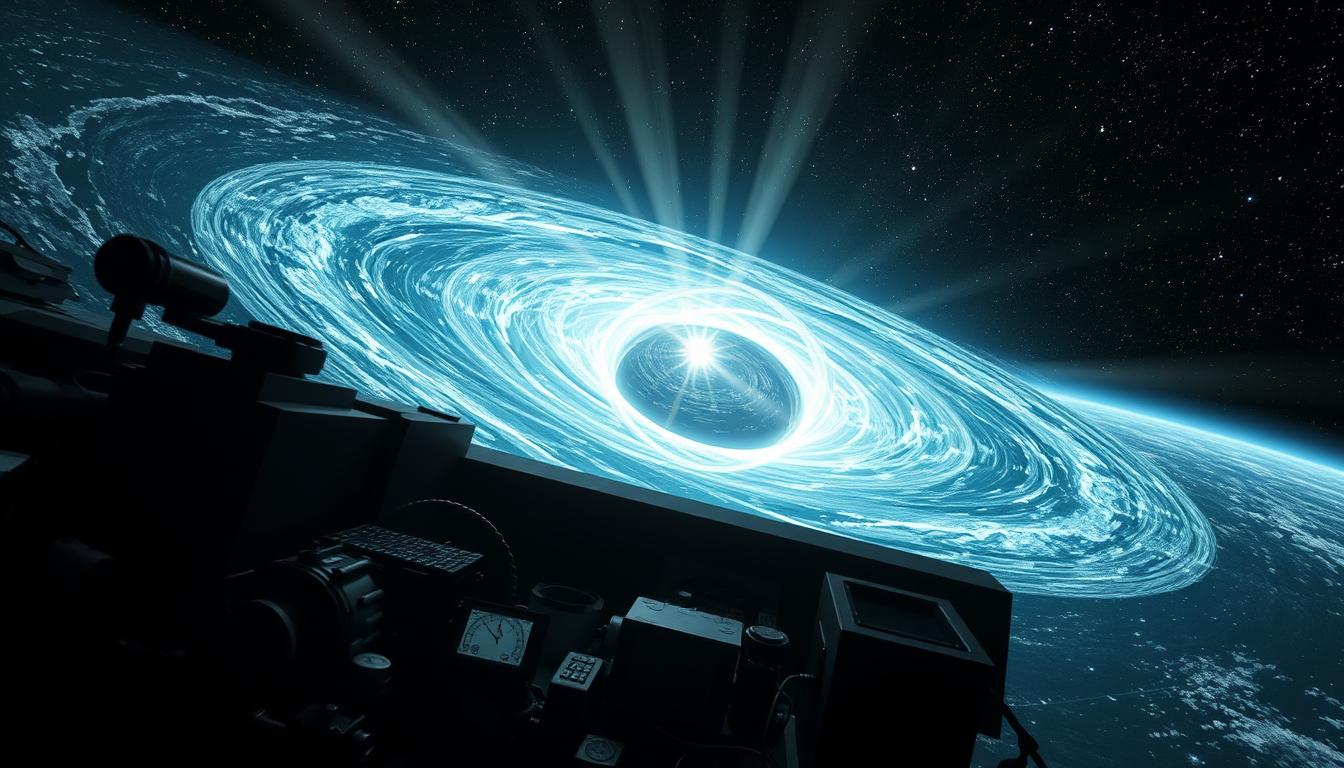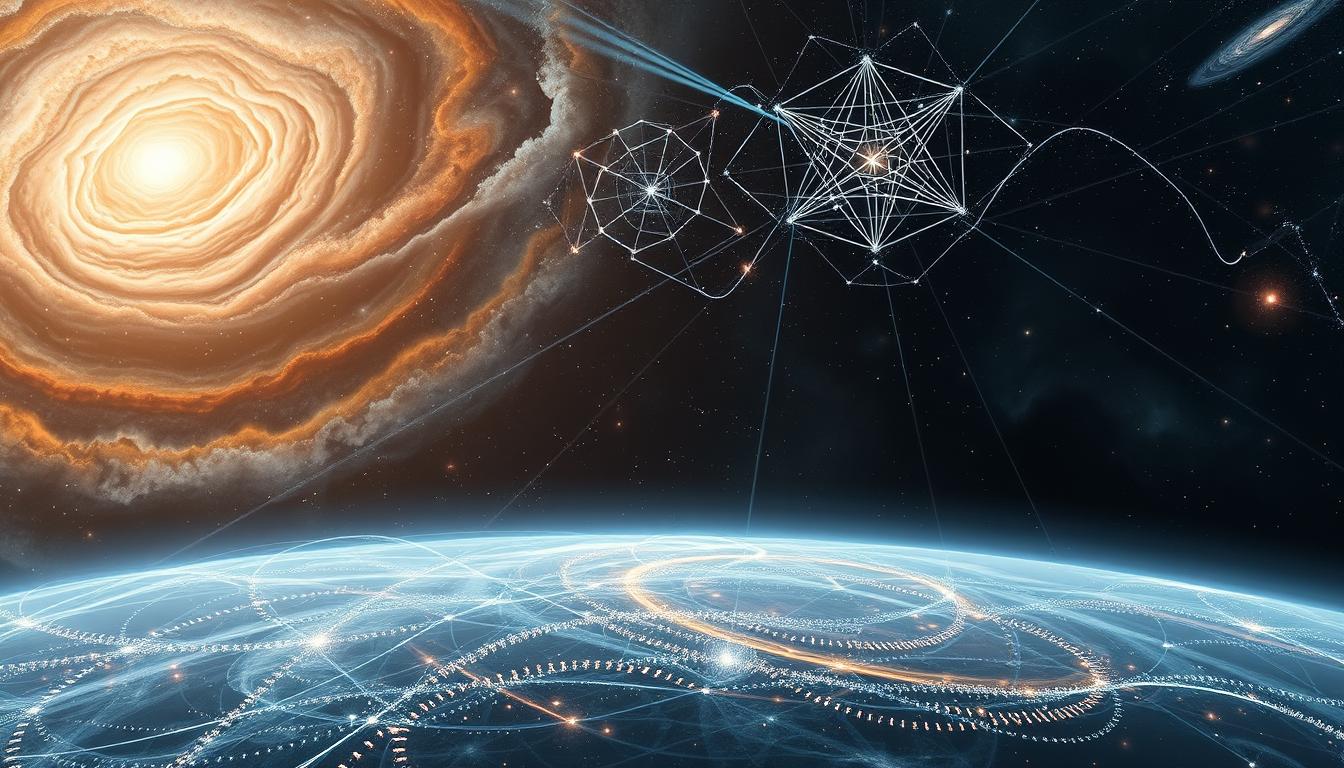You will hear about wormholes in some science-fiction books you read or movies (yes, you, Interstellar fan) and shows you watch about the universe. And it will follow with some complicated scientific explanation about what is a wormhole. They look good there, but are wormholes real? What if cosmic shortcuts exist, and they don’t just live in books, movies, or shows?
If you read my previous article about what is a wormhole, you already know that wormholes are basically theoretical tunnels through space and time. Einstein and Nathan Rosen first proposed them, and they are known as “Einstein-Rosen Bridges.” You just enter a tunnel from here in our Galaxy and end up in another part of the universe. At least, that’s what the idea proposes.
But are wormholes real, or could they be real? I’m going to try to separate science from magic. Theoretically, they are allowed in the equations of general relativity, but that doesn’t mean they’re hanging out next to Saturn and waiting for us to find them. Some recent experiments, like with Google’s Sycamore Quantum Computer, created small wormhole-like behavior simulations, but it’s very tiny.
I will try to keep it in plain English and make it simpler than most of the mentions of wormholes here on the internet and see if you can understand if they are wormholes real.

Understanding Wormholes: Theoretical Foundations and Historical Context
If you want to understand are wormholes real, you must understand the context behind, right? As I said, I have a whole article about this, but I’ll give a short introduction here just for the sake of context. If you already know what wormholes are, you can skip this section.
Wormholes first popped up in the math of general relativity, and physicists have been trying to make sense of them ever since. At first, they were just weird solutions to equations, then slowly started making their way into legitimate scientific discussions.
Imagine a tunnel through the cosmos, connecting distant points in an instant. This idea is known as a wormhole. Basically, you can travel from one point to another as if you are traveling in space (and maybe even time).
Einstein-Rosen Bridges and Early Theories
In 1935, physicists Albert Einstein and Nathan Rosen introduced the idea of bridges in spacetime. We call these structures Einstein-Rosen bridges now. They were initially linked to black holes. The idea was that black holes might not just be bottomless pits but could be connected to something else. Places like a mirror version of the universe or a different location in our universe. Their work suggested that extreme gravitational fields could create passages through the fabric of the universe.
The problem was that these “bridges” collapses really fast. There is no stability in the equations. Nevertheless, these early theories laid the groundwork for understanding how gravity and relativity might make wormholes possible.
The Evolution from Science Fiction to Scientific Inquiry
Even though Einstein and Rosen did come up with the idea in equations, they were not regarded as anything more than science fiction. People said it’s theoretically okay, but it can’t be real. This didn’t stop theoretical physicists, though.
Physicists started asking whether they could make one. Or at least find some proof they exist? What if a wormhole could be held open with exotic matter? What if we didn’t need to break the laws of physics entirely, just bend them a little? Now, things have gotten heated, and it has moved from science fiction to reality.
We still haven’t found or made wormholes in their real capacity, but at least we are trying now.
Are Wormholes Real? Scientific Perspectives
Now for the question of the hour: are wormholes real according to actual science? As fun as the concept is, scientists have to deal with things like physics, energy conservation, and peer pressure. On paper, they are possible, but they include materials that don’t exist yet and a lot of other complicated stuff.
They are mostly looking at whether these wormholes are and could be stable, traversable, and created without too much damage. Google’s latest experiment has shown a little bit of hope (more on this a little later), but it’s still basically nothing.
Debates on Negative Energy and Traversability
Wormholes, at least the ones we’d like to use for travel, need something wild called negative energy. This is one of the biggest challenges in creating a traversable wormhole. Unlike normal matter, negative energy could counteract the immense gravitational forces that would otherwise collapse such a tunnel.
The problem is, how do you find or create negative energy? Quantum physics gives us some hope here. The Casimir effect suggests that negative energy might exist in tiny amounts. But turning that tiny maybe into a stable, traversable tunnel through spacetime? It’s tricky, and that’s where we are mostly stuck.
Quantum Mechanics and the Holographic Principle
In theory, quantum mechanics could be one of the answers to finding or even creating a big wormhole. General relativity gave us the idea, but quantum mechanics is the thing that will and could move the idea further.
Physicists have been exploring whether quantum entanglement and spacetime geometry are more closely connected than we ever imagined. This is where we look into holographic principles and ER = EPR. This is the domain of blackboards covered in stuff we can’t understand that sounds like riddles, but it asks: could wormholes be quantum entanglement?
Quantum Entanglement and the ER = EPR Conjecture
ER = EPR conjecture is at the core of this. A theory that links entangled particles to structures like bridges in spacetime. Imagine two particles connected across long distances. This entanglement might create a passable wormhole, sort of a shortcut in the universe.
Leonard Susskind and Juan Maldacena proposed this theory, and it goes like this: maybe every pair of entangled particles is connected by a tiny, quantum-scale wormhole. That’s the “ER” (Einstein-Rosen bridge) part linked to the “EPR” (Einstein-Podolsky-Rosen entanglement paradox). Google’s Sycamore quantum computer aimed at looking into this and simulated it.
Duality Between Spacetime and Quantum Systems
There is a complex duality between spacetime itself and the quantum systems we work with. In one view, the universe is a big area of space and time. In another, it’s a complex network of particles and energy. The holographic principle says that these perspectives are two sides of the same coin. Everything happening inside a volume of space can be described by information on its boundary. Kind of like how a hologram stores 3D info on a flat, 2D surface. Similarly, the universe’s quantum mechanics might encode its spacetime structure.
Now, imagine if spacetime itself could be a projection of quantum data. That would mean wormholes, gravity, black holes, and others are just playing out stories that are encoded somewhere else in a simpler system. Reality might be far weirder than we experience it. It opens new ways to look at wormholes, not as glitches in the matrix but as natural byproducts of how the universe stores and connects information.

Insights from Recent Wormhole Experiments
As I mentioned a few times in the article, there have been recent experiments about wormholes. We are trying to use the highest technology available to us to simulate a wormhole-like environment on a minor scale. It aims to understand whether wormholes can exist beyond just theory. Google made a leap recently in its 2022 simulation.
Quantum Computer Simulations with Sycamore
Google’s Sycamore quantum computer has played a pivotal role in these breakthroughs. For those that don’t know, Sycamore Processer is basically a quantum machine beast that’s made specifically to do weird stuff like this. Simulating a wormhole-y thing was one of them. They simulated how quantum information could travel between two entangled systems in a way that mimics passing through a wormhole.
Google did this experiment in 2022 to simulate what could sort of resemble a wormhole. They didn’t open a portal or create a wormhole our size. The experiment showed how information could move in a way that mimics wormhole-like behavior. This is a big deal because it’s the first time we’ve seen something even remotely wormhole-y happening in an experimental setting.
Data Peaks and Experimental Signatures
During this experiment, they weren’t just guessing about the data and how it travels. They measured very specific data that showed the information behaved as expected if it had passed through a wormhole-like system. These aren’t giant wormholes swallowing satellites. They’re more like quantum whisper networks transferring a secret handshake between particles.
What do these data peaks mean? In simple terms, they show the moment information passes through the simulated wormhole. These are important for understanding how such shortcuts might function in reality. In this experiment, the signal looked right. The math held up. And while we’re still miles away from calling this “a real wormhole,” the fact that these signatures matched theoretical predictions is super exciting.

Reconciling General Relativity and Quantum Gravity
How do we bridge the gap between the vast cosmos and the tiny quantum world? If wormholes are ever going to move from theory to reality, we’ve got to solve one massive headache. General relativity and quantum mechanics really don’t play well together. Relativity describes the big stuff like planets, stars, and black holes. Quantum mechanics handles the tiny things like particles, atoms, and all the weird stuff at small scales. But wormholes? They exist somewhere in the middle.
So, how do we unite general relativity and quantum gravity? Well, we don’t know. We don’t have a playbook for this yet. It’s really hard. But we have some ideas.
Bridging Space, Time, and Gravity
At the core of this challenge is the need to gather the continuum of space and time with the quantized interactions of particles. General relativity describes gravity as the curvature of spacetime, while quantum mechanics focuses on discrete energy levels and probabilities. We need to merge these frameworks into a single, coherent theory.
In other words, wormholes naturally connect to general relativity, which deals with how mass and energy warp spacetime. But once we look into traversability, stability, or what’s going on inside the wormhole, quantum effects crash this whole thing. One promising approach involves the concept of spacetime duality. We discussed the idea a few headings before this one.
Challenges to Unifying Two Theories
These two theories speak two different languages like, Chinese and Greek. They are very different, and it is very hard to combine and understand both at the same time. General relativity is smooth, continuous, and geometric. Quantum mechanics is probabilistic, jumpy, and full of uncertainty. Trying to cram them into one framework is like trying to stuff spaghetti into a USB port.
Another challenge is also the experimental verification of such a unified theory. Theories like string theory and loop quantum gravity are attempts to make peace between the two. Wormholes keep popping up in those conversations as testing grounds. If wormholes are bridges in spacetime and are linked to entangled particles, then they might also be the Rosetta Stone we need. It may help us to decode how space, time, and quantum physics work together.
Conclusion
Wormholes are theoretical tunnels in space that can move you from one place in the universe to another. How? Why? We don’t know. Are wormholes real for sure? That’s also not certain. We know on paper they exist. They must be somewhere. General relativity says so, at least. We are struggling with getting general relativity and quantum mechanics together. It’s a long and tough journey. Google made a big step with its Sycamore Quantum Processor in 2022, but it was on a quantum scale. We still have a lot of work to do to prove if “are wormholes real?”
If we know they may exist on paper, we will find a way to create one or at least find one out there in the universe. Maybe black holes are wormholes. If that’s the case, then we’ll never know if they are real.
FAQ
What is an Einstein-Rosen bridge?
An Einstein-Rosen bridge is a theoretical concept in general relativity that suggests a shortcut through spacetime. It’s often linked to the idea of a wormhole connecting two distant regions of the universe.
Can wormholes exist in reality?
While wormholes are mathematically possible within Einstein’s equations, their existence remains unproven. They require exotic matter or negative energy, which hasn’t been observed in nature.
How do quantum mechanics relate to wormholes?
Quantum mechanics introduces ideas like entanglement, which some theories connect to wormholes. The ER = EPR conjecture suggests a deep link between spacetime geometry and quantum particles.
Have scientists ever simulated a wormhole?
Yes, researchers used quantum computers like Google’s Sycamore to simulate wormhole dynamics. These experiments provide insights but don’t create actual wormholes.
What recent experiments have advanced our understanding of wormholes?
Quantum simulations, like those on Google’s Sycamore processor, have modeled wormhole behavior. These experiments help test theoretical predictions in a controlled environment.